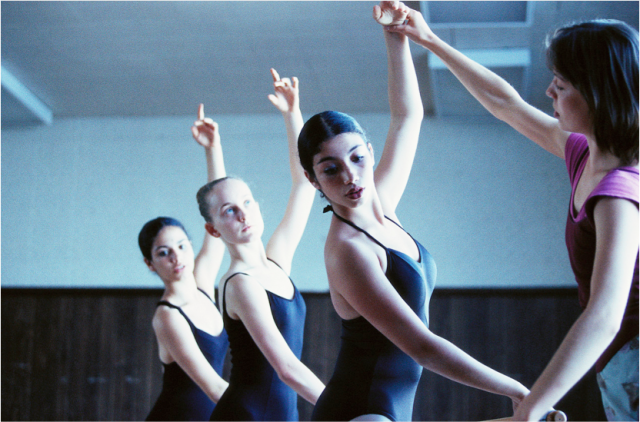 Whenever you think about nutrition in the United States, chances are you wonder why Americans consume so much food. When you read the government’s 2010 statistics, which shows that one in every three Americans is obese, the seriousness of the problem is quite obvious.1 Dancers are generally not affected by this problem because of the frequency and intensity of the mere act of dancing. From a young age, dancers have studied and learned the details of form and technique - they have slowly developed a unique, personal style that helps them express their deepest feelings and emotions. A dancer’s body curls, lengthens and spins creating an illusion, becoming art.
Whenever you think about nutrition in the United States, chances are you wonder why Americans consume so much food. When you read the government’s 2010 statistics, which shows that one in every three Americans is obese, the seriousness of the problem is quite obvious.1 Dancers are generally not affected by this problem because of the frequency and intensity of the mere act of dancing. From a young age, dancers have studied and learned the details of form and technique - they have slowly developed a unique, personal style that helps them express their deepest feelings and emotions. A dancer’s body curls, lengthens and spins creating an illusion, becoming art.
That artistic instrument that is your body requires certain amounts of fuel, in the form of food that will be burned while taking classes, rehearsing and performing. There is a syndrome that alters the body’s functions when the amount of calories burned is more than the ones that you eat - this syndrome is called the Female Athlete Triad and it affects dancers and other athletes who are required to maintain a slim figure.2 This syndrome is referred to as a “triad” because it has three components: 1. decreased energy, 2. abnormal menstruation and 3. weak bones. The syndrome typically starts when your body burns more calories than the ones you consume. Some dancers aren't aware of the fact that they’re not eating an adequate amount yet others do it consciously because of fear of gaining weight. You can tell this is happening to you if you are losing weight, feeling constantly tired and there is a perpetual sensation of coldness in your hands and feet.3 If this happens for a long period of time, your menstrual cycle will become irregular or it could stop for a few months. An irregular or absent menstrual cycle will subsequently affect your bone health and this can eventually lead to osteoporosis (weak bones) and fractures.
"Some dancers aren't aware of the fact that they’re not eating an adequate amount yet others do it consciously because of fear of gaining weight."
The Female Athlete Triad affects adolescents and young adults who participate in sports like long distance running, diving, gymnastics and dance. The components of the Triad can happen independently. You could be eating well and still have absence of your menstrual cycle for several months. This occurs to many athletes who participate in intense training and the cause is usually that their percent body fat is bellow 22%.4 If your menstruation is abnormal, contact your health care professional because you could be at risk of developing osteoporosis and other health problems.
For those of you who struggle with body weight, blame it on the culture of thinness.5 We currently live in a society that sees beauty in people who are slim and this dramatically influences the way we think and behave. Being slim is fine, but in order to perform well as a dancer you need to maintain healthy eating habits. If you are unhappy with the way you look and would prefer to lose weight, a nutritionist can be of immense help. They can assist you at finding a balance between nutrition and a training intensity that will work for you. They will also assist you in establishing healthy and realistic short-term goals - goals that are achievable will make you feel good about the effort you are putting in. A nutritionist will also discuss the possibility of using positive reinforcement. Positive reinforcement is a reward for your accomplishments. The reward can come from yourself, your parents, friends or your teacher. When you are rewarded for your achievements, you are more likely to repeat healthy behaviors that helped you achieve them in the first place.
"In adolescents, the basic healing time for a fractured bone is approximately two months for fractures in the arms and three months for fractures in the legs. It can take anywhere from 2 to 5 years for anyone to heal 100%.7 It is ideal to prevent these problems rather than to have to deal with them in the future."
Besides a nutritionist, there are other professionals who are available to you. Psychological counseling is sometimes recommended for dancers whose body image dissatisfaction leads to disordered eating. During a counseling session with a psychologist you will explore the reasons behind your behavior and will find ways to modify it. Most people feel good about sharing their feelings with someone who is there to listen, be impartial and offer advice. When talking to a psychologist you could create behavioral contracts - these are small agreements that you will determine and that you will try to stick to during a certain period of time. You create the rules depending on what you want to accomplish. This type of open one-to-one conversation can be very rewarding.
In some instances your physician will be the best person to talk to. Your physician might ask you to answer a questionnaire called the Pre-Participation Exam.6 This exam contains 12 questions that can determine if you are at risk of developing one or more of the components of the Triad. If you and your physician determine that you are at risk, they will guide you as to what to do next. As long as you have a desire and willingness to change, negative effects on your health can be prevented.
 I am a physiotherapist and, unfortunately, I meet dancers quite often when they have already suffered an injury caused by the "triad". The most frequent injury that we see is a stress bone fracture but some dancers suffer muscle and ligament injuries as well. The rehabilitation can be long and painful and you will not be unable to work and rehearse during that time period of healing. In adolescents, the basic healing time for a fractured bone is approximately two months for fractures in the arms and three months for fractures in the legs. It can take anywhere from 2 to 5 years for anyone to heal 100%.7 It is ideal to prevent these problems rather than to have to deal with them in the future. Think seriously about this information. The first step to prevent and treat the Female Athlete Triad is by being aware of its existence, which is something you have done just by simply reading this article. If you decide that there is a problem related to your weight and how it is affecting your dance career, talk to somebody about it. It could be your fellow dancers, your friends or any health care provider with whom you feel comfortable speaking.
I am a physiotherapist and, unfortunately, I meet dancers quite often when they have already suffered an injury caused by the "triad". The most frequent injury that we see is a stress bone fracture but some dancers suffer muscle and ligament injuries as well. The rehabilitation can be long and painful and you will not be unable to work and rehearse during that time period of healing. In adolescents, the basic healing time for a fractured bone is approximately two months for fractures in the arms and three months for fractures in the legs. It can take anywhere from 2 to 5 years for anyone to heal 100%.7 It is ideal to prevent these problems rather than to have to deal with them in the future. Think seriously about this information. The first step to prevent and treat the Female Athlete Triad is by being aware of its existence, which is something you have done just by simply reading this article. If you decide that there is a problem related to your weight and how it is affecting your dance career, talk to somebody about it. It could be your fellow dancers, your friends or any health care provider with whom you feel comfortable speaking.
Hector Lozada, Physiotherapist, doctoral student at Boston University. Email: hlozada@bu.edu
References:
1. Ogden CL, Carroll MD, Kit BK, Flegal KM. Prevalence of Obesity in the United States, 2009–2010. U.S. Department of Health and Human Services, Centers for Disease Control and Prevention, National Center for Health Statistics. NCHS Data Brief, 82;2012.
2. Barrack MT, Ackerman KE, Gibbs JC. Update on the female athlete triad. Curr Rev Musculoskelet Med. 2013;6(2): 195–204.
3. Signs of the Triad. Female Athlete Triad Coalition. Available at: http://www.femaleathletetriad.org/for-athletes-coaches/signs-of-the-triad/. Accessed October 15, 2013.
4. Rintala M, Mustajoki P. Could mannequins menstruate? BMJ. 1992;305:1575-1576.
5. Halliwell E. The impact of thin idealized media images on body satisfaction: Does body appreciation protect women from negative effects? Body Image. 2013;10(4):509-514.
6. De La Torre DM, Snell BJ. Use of the preparticipation physical exam in screening for the female athlete triad among high school athletes. J Sch Nurs. 2005;21(6):340-5.
7. Weerakkody Y, Schubert R. Fracture Healing. Radiopedia web site. Available at: http://radiopaedia.org/articles/fracture-healing. Accessed October 15, 2013.